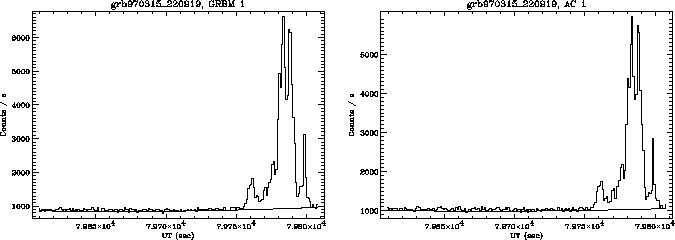 |
![[*]](crossref.png) : this is an OTB,
that triggered the GRBM on board at 22:09 UT, on March 15, 1997.
Another advantage from using the SWTCs is the detection of very weak
(in the 40-700 keV band) and soft bursts, with peak fluxes of
: this is an OTB,
that triggered the GRBM on board at 22:09 UT, on March 15, 1997.
Another advantage from using the SWTCs is the detection of very weak
(in the 40-700 keV band) and soft bursts, with peak fluxes of
![[*]](crossref.png) ,
fig.
,
fig. ![[*]](crossref.png) ,
, ![[*]](crossref.png) ).
).
 |
The drawback of these SWTCs is the background estimate: since this is computed with a simple moving average, involving only the bins preceding the scanned bin, several NTBs are biased, owing bad background subtraction.
Another consequence of the wrong background estimate is the detection of many false NTBs, that do not correspond to any real transient increase in the ratemeters, but are simply due to medium- or long-term variations in the background level. This unfortunate feature prevented the author from applying the early SWTCs to the on-line GRB quest; otherwise, there would be an excess of spurious triggers, in addition to strongly biased estimates of duration, peak count rate, total counts for many real bursts.
In summary, the early SWTCs are good in detecting many transient events occurring near ``critical'' points in the ratemeter time histories; nevertheless, owing to the naive method used for the background fit, some relevant characteristics, like peak count rate, duration, total counts, have to be further refined after visual inspection.